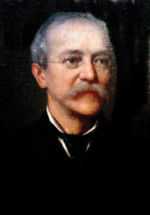John Jay Knox


John Jay Knox (1828 - 1892) was an American financier, born in Knoxboro, New York. He graduated from Hamilton College in 1849 and entered the banking business.
He was a vigorous supporter of the national banking plan of Treasury Secretary Salmon P. Chase. Chase appointed Knox to a clerkship position in the Treasury Department after reading an essay Knox wrote in 1862 that urged for a national banking system. Knox held several other positions before being made Deputy Comptroller of the Treasury in 1867. President Ulysses S. Grant promoted Knox to Comptroller of the Treasury in 1872. In 1884 Knox resigned his post in order to become president of the National Bank of the Republic in New York City, a position he held until his death.
In 1870 he helped prepare a bill codifying the mint and coinage laws. The bill (H.R. 2934) was transmitted to Congress by Treasury Secretary George S. Boutwell and with a few amendments was signed into law by President Grant on February 12, 1873. This was the famous Coinage Act of 1873, which dropped the silver dollar from coinage.
Knox was the author of several works including United States Notes (New York, 1887).
| Political offices | ||
|---|---|---|
| Preceded by Hiland R. Hulburd |
Comptroller of the Currency 1872–1884 |
Succeeded by Henry W. Cannon |
References
-
 This article incorporates text from a publication now in the public domain: Gilman, D. C.; Thurston, H. T.; Moore, F., eds. (1905). "article name needed". New International Encyclopedia (1st ed.). New York: Dodd, Mead.
This article incorporates text from a publication now in the public domain: Gilman, D. C.; Thurston, H. T.; Moore, F., eds. (1905). "article name needed". New International Encyclopedia (1st ed.). New York: Dodd, Mead. - "Knox, John Jay." Dictionary of American Biography. Ed. Dumas Malone. Vol. 10. New York: Charles Scribner's Sons, 1943.
|